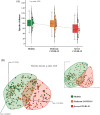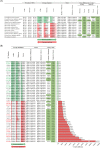Untangling the link between the human gut microbiota composition and the severity of the symptoms of the COVID-19 infection
- PMID: 36086955
- PMCID: PMC9538590
- DOI: 10.1111/1462-2920.16201
Untangling the link between the human gut microbiota composition and the severity of the symptoms of the COVID-19 infection
Abstract
Recent pandemic infection caused by SARS-CoV-2 (COVID-19) led the scientific community to investigate the possible causes contributing to the physiopathology of this disease. In this context, analyses of the intestinal microbiota highlighted possible correlation between host-associated bacterial communities and development of the COVID-19. Nevertheless, a detailed investigation of the role of the human microbiota in the severity of the symptoms of this disease is still lacking. This study performed a comprehensive meta-analysis of 323 faecal samples from public and novel Italian data sets based on the shotgun metagenomic approach. In detail, the comparative analyses revealed possible differences in the microbial biodiversity related to the individual health status, highlighting a species richness decrease in COVID-19 patients with a severe prognosis. Moreover, healthy subjects resulted characterized by a higher abundance of protective and health-supporting bacterial species, while patients affected by COVID-19 disease displayed a significant increase of opportunistic pathogen bacteria involved in developing putrefactive dysbiosis. Furthermore, prediction of the microbiome functional capabilities suggested that individuals affected by COVID-19 subsist in an unbalanced metabolism characterized by an overrepresentation of enzymes involved in the protein metabolism at the expense of carbohydrates oriented pathways, which can impact on disease severity and in excessive systemic inflammation.
© 2022 The Authors. Environmental Microbiology published by Society for Applied Microbiology and John Wiley & Sons Ltd.
Conflict of interest statement
The authors declare no competing financial interests.
Figures


References
-
- Andrade, B.G.N. , Cuadrat, R.R.C. , Tonetti, F.R. , Kitazawa, H. & Villena, J. (2022) The role of respiratory microbiota in the protection against viral diseases: respiratory commensal bacteria as next‐generation probiotics for COVID‐19. Bioscience of Microbiota, Food and Health, 41, 94–102. - PMC - PubMed
Publication types
MeSH terms
LinkOut - more resources
Full Text Sources
Medical
Miscellaneous

